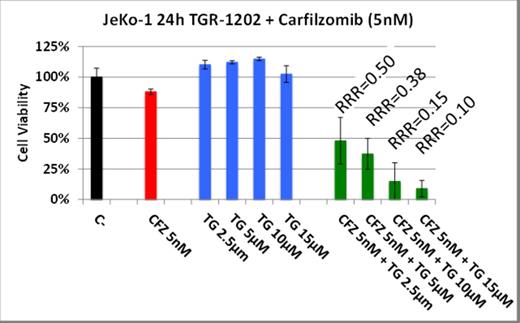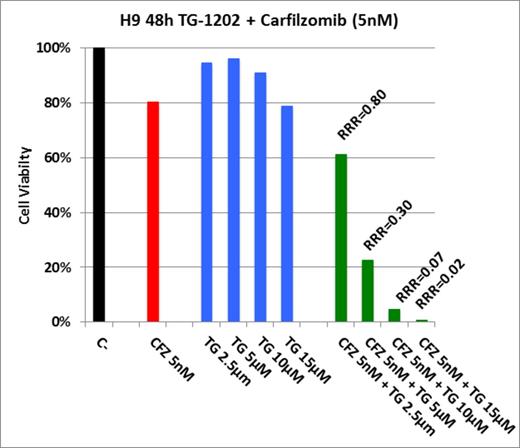The constitutively activated PI3K/AKT/mTOR pathway plays a key role in the proliferation and survival of cancer cells. Specific inhibitors of the delta isoform of PI3K, such GS-1101 (idelalisib), have shown promising activity in the treatment of B-cell lymphoma. In contrast, some data from models of T-cell lymphoma (TCL) have suggested that these diseases may require inhibition of both PI3Kdelta and PI3Kgamma for optimal cytotoxicity. Proteasome inhibitors, such as carfilzomib, potently inhibit the activation of NF-kappaB (NF-kB) by preventing degradation of the NF-kB inhibitor IkB. We hypothesize that inhibition of this pathway at both the proximal (PI3K) and distal (NF-kB) aspects, using both inhibitors of PI3K and proteasome, could lead to a synergistic cyototoxic effect in models of lymphoma.
Cytotoxicity of TGR-1202 and carfilzomib was studied in a panel of B and T-cell lymphoma cell lines. Growth inhibition was determined using Cell TiterGlo that measures ATP produced by live and proliferating cells. Cell death was determined by flow cytometry, using the probes Annexin V and propidium iodide. Drug: drug synergy was determined by calculating relative risk ratio (RRR). Values below 1 indicate synergy, with smaller RRR values corresponding to higher levels of synergy.
TGR-1202 as a single agent active against a panel of diverse B- and T-lymphomas. By the Cell TiterGlo assay, the concentration required to inhibit growth by 50% (IC50) following 48-hour exposure ranged from 10 uM to 15 uM in most of the cell lines. Maver and H9, representing mantle cell lymphoma (MCL) and TCL respectively, were more resistant to TGR-1202. Carfilzomib, on the other hand, is a potent inhibitor of B- and T cell lymphomas, with an IC50 in the range of 2-8 nM most lymphomas (Table 1). Remarkably, when TGR-1202 is combined with carfilzomib at minimally, or mildly inhibitory concentrations, there was a highly synergistic inhibition in both B and T-cell lymphomas. Following a 24 hour exposure, carfilzomib alone achieved only 20% growth inhibition of the MCL cell line Jeko-1, while TGR-1202 at concentrations ranging from 2.5 to 15 uM did not produce any growth inhibition (Figure 1). However, the combination of carfilzomib and TGR-1202 markedly inhibited growth of Jeko-1, with a synergy index, RRR, as low as 0.10. In contrast, the synergy of carfilzomib and TGR-1202 in the TCL cell line H9 following a 48-hour exposure, as shown in Figure 2, demonstrated remarkable synergy with a RRR as low as 0.02. To further confirm the synergy of these two drugs in lymphoma, apoptosis was determined in H9 cells treated either with each drug as a single agent or together in combination. Figure 4 illustrates that the combination of these two drugs at marginally active concentrations caused apoptosis in as many as 90% of the H9 cells. The synergy of TGR-1202 and carfilzomib stood out among the combinations tested, as being among one of the most synergistic combinations explored. Table 2 contains a summary of the synergy seen with TGR-1202 and carfilzomib, in contrast to the effects seen with other drug: drug combinations.
The combination of carfilzomib and TGR-1202 inhibited MCL cells in a highly synergistic manner at 24-hour of exposure.
The combination of carfilzomib and TGR-1202 inhibited MCL cells in a highly synergistic manner at 24-hour of exposure.
The combination of carfilzomib and TGR-1202 inhibited TCL cells in a highly synergistic manner at 48-hour of exposure.
The combination of carfilzomib and TGR-1202 inhibited TCL cells in a highly synergistic manner at 48-hour of exposure.
IC50 of carfilzomib in B- and T-cell lymphoma cells.
| Cell line | Lymphoma | IC50 (nM) |
| LY1 | DLBCL | 8.1 |
| LY10 | DLBCL | 1.8 |
| Rec-1 | MCL | NR |
| HBL2 | MCL | 2.4 |
| Maver | MCL | 5.6 |
| HH | CTCL | 3.9 |
| H9 | CTCL | 4.0 |
| Cell line | Lymphoma | IC50 (nM) |
| LY1 | DLBCL | 8.1 |
| LY10 | DLBCL | 1.8 |
| Rec-1 | MCL | NR |
| HBL2 | MCL | 2.4 |
| Maver | MCL | 5.6 |
| HH | CTCL | 3.9 |
| H9 | CTCL | 4.0 |
Summary of drug: drug interaction between PK3K and proteasome inhibitors as measured by RRR.
 |
 |
In conclusion, the combination of the PI3K delta inhibitor TGR-1202 and the proteasome inhibitor carfilzomib remarkably and distinctively synergize to kill both B and T-cell lymphoma cells, and represents a promising therapeutic strategy in the treatment of these diseases.
C-: Negative control
CFZ: carfilzomib
TG: TGR-1202
RRR: Relative risk ratio. Values below 1 indicate synergy.
C-: Negative control
CFZ: carfilzomib
TG: TGR-1202
RRR: Relative risk ratio. Values below 1 indicate synergy.
NR: IC50 was not reached at the highest tested concentrations of 32 nM.
DLBCL: Diffuse large B cell lymphoma
MCL: Mantle cell lymphoma
CTCL: Cutaneous T cell lymphoma
Sportelli: TG Therapeutics, Inc. : Employment, Equity Ownership. Miskin:TG Therapeutics, Inc.: Employment, Equity Ownership. Vakkalanka:3Rhizen Pharmaceuticals: Employment, Equity Ownership. Viswanadha:Incozen Therapeutics Pvt. Ltd.: Employment, Equity Ownership.



